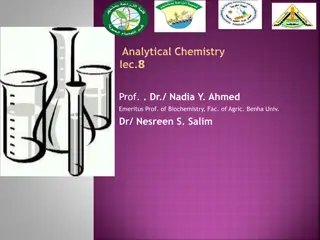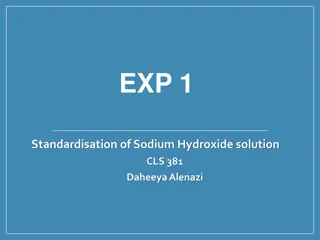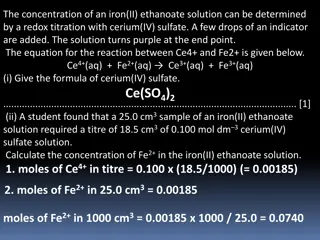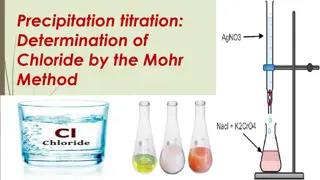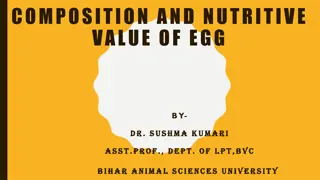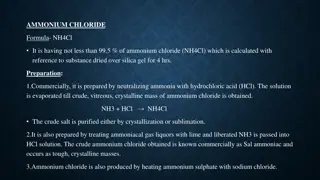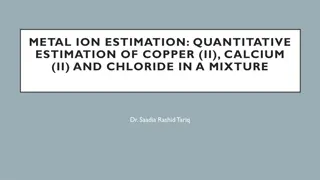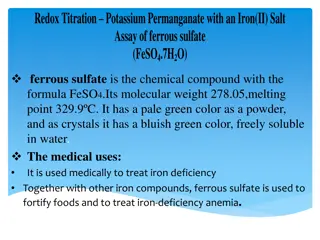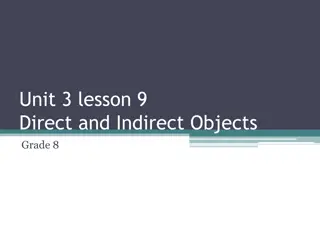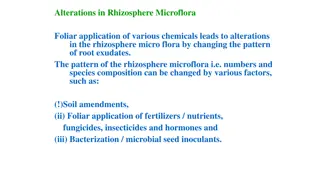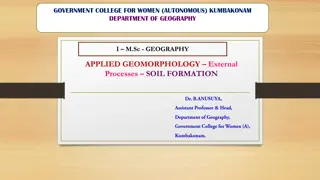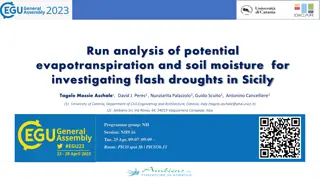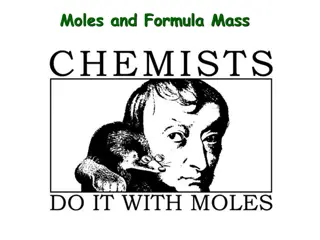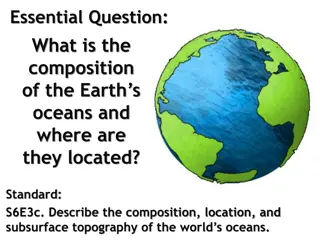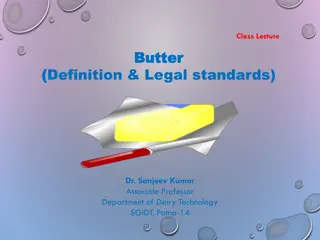Understanding Direct Titration in Analyzing Soil Composition
Exploring the concept of direct titration in soil analysis, focusing on its role in determining the concentration of compounds such as calcium and magnesium ions. This method involves the direct reaction between the unknown compound and a known compound, without the need for excess reagents. Learn how this technique is applied in estimating the composition of soil samples, along with practical examples and considerations for accurate results.
Download Presentation

Please find below an Image/Link to download the presentation.
The content on the website is provided AS IS for your information and personal use only. It may not be sold, licensed, or shared on other websites without obtaining consent from the author. Download presentation by click this link. If you encounter any issues during the download, it is possible that the publisher has removed the file from their server.
E N D
Presentation Transcript
SECTION A Analysis of soil (contd) DEPARTMENT OF CHEMISTRY SGGSJ GOVT COLLEGE PAONTA SAHIB
Chelation,chelating agents Use of metal ion indicators. Complexometric titration Estimation of calcium and magnesium ions in soil by complexometric titration DEPARTMENT OF CHEMISTRY SGGSJ GOVT COLLEGE PAONTA SAHIB
DEPARTMENT OF CHEMISTRY SGGSJ GOVT COLLEGE PAONTA SAHIB
Back Titration: A back titration is a titration method used to determine the concentration of an unknown using an excess amount of a compound with a known concentration. Direct Titration: A direct titration is the basic titration method that involves the reaction between the unknown compound and the compound with known concentration DEPARTMENT OF CHEMISTRY SGGSJ GOVT COLLEGE PAONTA SAHIB
What is Direct Titration A direct titration is the basic titration method that involves the reaction between the unknown compound and the compound with known concentration. Here, the addition of excess reagents is not done as in back titrations. The unknown compound is directly reacted with the known compound. Therefore, the end point of the titration indicates the end of the reaction. By using that endpoint, the amount of unknown compound present in the sample solution can be determined. DEPARTMENT OF CHEMISTRY SGGSJ GOVT COLLEGE PAONTA SAHIB
In a direct titration, you add a standard titrant to the analyte until you reach the end point. In a back titration, you add an excess of standard titrant to the analyte, and then you titrate the excess titrant to determine how much is in excess. It is often preferable to do a back titration if 1. one of the reactants is volatile and some might escape during the titration (e.g., NH ) 2. the analyte is an insoluble salt (e.g., CaCO ) 3. a particular reaction is too slow 4. direct titration would involve a weak acid-weak base titration (difficult to observe the end point) DEPARTMENT OF CHEMISTRY SGGSJ GOVT COLLEGE PAONTA SAHIB
To determine the mass of calcium carbonate present in a sample of chalk 1. Placed the sample in a 250 mL conical flask and added 50.00 mL 0.2000 mol/L HCl from a volumetric pipette. 2. 50 0.2000/1000 = .01000 moles of HCl added to chalk 3. Titrated the excess HCl with 0.2000 mol/L NaOH and found an average titre of 40.00 mL. 0.2000 40/1000= .008000 moles of NaOH to neutralize the excess HCl. The chalk must have reacted with 0.002 00 mol of the HCl. Since 1 mol of CaCO reacts with 2 mol of HCl, there must have been 0.001 00 mol of CaCO . The mass of CaCO in the chalk was (0.001 00 100.09) g = 0.100 g. DEPARTMENT OF CHEMISTRY SGGSJ GOVT COLLEGE PAONTA SAHIB 4. 5. 6. 7.
DEPARTMENT OF CHEMISTRY SGGSJ GOVT COLLEGE PAONTA SAHIB
DEPARTMENT OF CHEMISTRY SGGSJ GOVT COLLEGE PAONTA SAHIB
The Chelate Effect It is a general property of multi- dentate ligands like EDTA, that they will form a 1:1 complex with the metal ion, thus greatly simplifying the above equilibrium equations. Further, their binding constants are much stronger than those of unidentate ions. There are a several of reasons for this. One reason that multidentate ions have strong interactions is that while an individual interaction with the central metal may be weak, the total interaction ends up multiplying all the small interaction together to become a large number. DEPARTMENT OF CHEMISTRY SGGSJ GOVT COLLEGE PAONTA SAHIB
A second reason would be cooperativity. Once the EDTA is bound at one site, the metal and the EDTA are now physically tied together so the second site is physically close and can bind almost instantly. A third, more subtle argument effect is based on the entropy of the reaction. Entropy is a measure of randomness, and thing that more ordered are generally less favored than thing that are more random. If we have a complex between 1 metal and 6 monodentate ligands, you enforce order on 7 different compounds. If you have a complex between a metal and a single 6- dentate ligand, you only enforce order on two molecules, so this is much more favored DEPARTMENT OF CHEMISTRY SGGSJ GOVT COLLEGE PAONTA SAHIB
ETHYLENE DIAMMINE (BIDENTATE) Ligands with two or more points of attachment to metal atoms are called chelating ligands, and the compounds they make are called chelates, a name derived from the Greek word khele, or claw of a crab. DEPARTMENT OF CHEMISTRY SGGSJ GOVT COLLEGE PAONTA SAHIB
Denticity refers to the number of atoms with which a ligand binds to a metal ion. A ligand could be monodentate, meaning it binds through a lone pair on a single atom. It could be bidentate, meaning it binds through lone pairs on two different atoms. It could even be tridentate, with three atoms bearing their own lone pairs, tetradentate, and so on. The words, polydentate and multidentate, are two general terms for ligands that bind through more than one atom. The words chelator and chelating ligand are also general terms used to refer to these ligands. DEPARTMENT OF CHEMISTRY SGGSJ GOVT COLLEGE PAONTA SAHIB
DENTICITY 2 There is a symbol for denticity, (it's a Greek letter, pronounced "kappa"), which simply describes how many atoms are bound to the metal. For example, in ethylenediamine or 1,2- diaminoethane, NH2CH2CH2NH2, the two nitrogen atoms can be bound to the metal at the same time, although none of the other atoms in between would be directly attached to the metal. This donor is capable of binding in a 2mode DEPARTMENT OF CHEMISTRY SGGSJ GOVT COLLEGE PAONTA SAHIB
PENTA AND HEXADENTATE TRI AND TETRADENTATE DEPARTMENT OF CHEMISTRY SGGSJ GOVT COLLEGE PAONTA SAHIB
Chelation /kilen/ is a type of bonding of ions and molecules to metal ions. It involves the formation or presence of two or more separate coordinate bonds between a polydentate (multiple bonded) ligand and a single central atom.[1][2] DEPARTMENT OF CHEMISTRY SGGSJ GOVT COLLEGE PAONTA SAHIB
DEPARTMENT OF CHEMISTRY SGGSJ GOVT COLLEGE PAONTA SAHIB
EDTA forms an octahedral complex with most 2+ metal cations, M2+, in aqueous solution. The main reason that EDTA is used so extensively in the standardization of metal cation solutions is that the formation constant for most metal cation-EDTA complexes is very high, meaning that the equilibrium for the reaction: M2++ H4Y MH2Y + 2H+lies far to the right. Carrying out the reaction in a basic buffer solution removes H+as it is formed, which also favors the formation of the EDTA-metal cation complex reaction product. For most purposes it can be considered that the formation of the metal cation-EDTA complex goes to completion, and this is chiefly why EDTA is used in titrations and standardizations of this type. DEPARTMENT OF CHEMISTRY SGGSJ GOVT COLLEGE PAONTA SAHIB
To carry out metal cation titrations using EDTA, it is almost always necessary to use a complexometric indicator to determine when the end point has been reached. Common indicators are organic dyes such as Fast Sulphon Black, Eriochrome Black T, Eriochrome Red B, Patton Reeder, or Murexide. Color change shows that the indicator has been displaced (usually by EDTA) from the metal cations in solution when the end point has been reached. Thus, the free indicator (rather than the metal complex) serves as the endpoint indicator. DEPARTMENT OF CHEMISTRY SGGSJ GOVT COLLEGE PAONTA SAHIB
These indicators are used in complexometric titration.These indicators undergo colour change in presence of a specific metal ion.They indicate the exact moment when all the metal ions in the solution are complexed by a chelating agent like EDTA. Example :Mureoxide,EBT,Calcon DEPARTMENT OF CHEMISTRY SGGSJ GOVT COLLEGE PAONTA SAHIB
CHEMICAL FORMULA: C20H12N3O7SNA It is also known as Solochrome Black T.It can be used in the pH range 6-7. Below pH 5.3 the solution of EBT is red ,between 7and 11 it is blue and above 11.5 it is Red. The colour change can be observed with ions of Mg,Mn,Zn,Cd,Hg,Pb ,Ca,Ba. Required pH range is maintaned by adding buffer of ammonia and ammonium chloride. DEPARTMENT OF CHEMISTRY SGGSJ GOVT COLLEGE PAONTA SAHIB
A titration of Eriochrome black T indicator and Mg solution with EDTA. The end point of the titration is when the Mg-Indicator complex (red) is completely dissociated and the becomes Mg-EDTA and free Indicator (blue) DEPARTMENT OF CHEMISTRY SGGSJ GOVT COLLEGE PAONTA SAHIB
It is ammonium salt of purpuric acid. It can be repesented as H4D- Mureoxide may be employed for the direct titration of calcium at ph 11 The colour change at end point is red to violet blue DEPARTMENT OF CHEMISTRY SGGSJ GOVT COLLEGE PAONTA SAHIB
Determine the amount of Ca present as Calcium carbonate in soil sample Principle: Calcium present in soil extract is titrated against 0.01 N EDTA solution using mureoxide indicator. Chemicals required: 0.01N EDTA solution,Mureoxide indicator,1N NaOH solution,1N Ammonium acetate solution. DEPARTMENT OF CHEMISTRY SGGSJ GOVT COLLEGE PAONTA SAHIB
Preparation of soil extract 1 a) Take 100 ml of 40% ethanol in a conical flask.Add 50 g of dry soil to it and shake.Filter the suspension after sometime through Whatman filter paper 50 and wash the soil residue with 40% ethanol twice and collect the filtrate in 250ml flask. 1 b) Take the soil residue from above step ,add 100ml of ammonium aetate solution .Shake and let it stand undisturbed for 24 hrs.Filter and collect filtrate. Mix the filtrates of step 1a) and 1b) and note the volume of soil extract prepared. DEPARTMENT OF CHEMISTRY SGGSJ GOVT COLLEGE PAONTA SAHIB
Pipette out 20ml of soil extract from step 1 in a conical flask .Add 2ml of 1N NaOH solution and 3-4 drops of mureoxide indicator. Titrate the mixture with 0.01 N EDTA solution taken in the burette . The colour will change from red to purple at the end point. Repeat the titration to get concordant readings. DEPARTMENT OF CHEMISTRY SGGSJ GOVT COLLEGE PAONTA SAHIB
Let the volume of 0.01 N EDTA solution is V ml(Burette reading) Amount of soil extract used =20ml(In flask) Aplying Normality equation (Soil extract)N1 V1= N2 V2 (EDTA) N1 20= 1/100 V2 N1= V2/2000 STRENGTH= N1 50(Equivalent weight) = A mg/ml or A g/L DEPARTMENT OF CHEMISTRY SGGSJ GOVT COLLEGE PAONTA SAHIB
To determine Magnesium content in soil sample Chemicals required: 0.01 N EDTA solution NH4Cl and NH4OH buffe solution of ph 10 1N NaOH solution Mureoxide and EBT indicators DEPARTMENT OF CHEMISTRY SGGSJ GOVT COLLEGE PAONTA SAHIB
First the total amount of Ca and Mg present in soil is determined by titration with 0.01 N EDTA solution using EBT indicator at ph 10. The soil extract is then titrated with EDTA solution with mureoxide as indicator inalkaline solution to determine the amount of Ca alone. From the difference in the volume of .01N EDTA used in the two titrations ,amount of Mg can be determined in the soil sample. DEPARTMENT OF CHEMISTRY SGGSJ GOVT COLLEGE PAONTA SAHIB
Step 1 :Preparation of soil extract (Same as in step 1 of experiment 1) Step 2: Titration of sol extract using EBT indicator 20ml of soil extract+20 ml of distilled water+5ml of NH4Cl and NH4OH buffer solution+ 4 drops EBT in a flask. Titrate with .01N EDTA solution taken in burette till color changes from wine red to blue.This is the end point. Repeat for three concordant readings. DEPARTMENT OF CHEMISTRY SGGSJ GOVT COLLEGE PAONTA SAHIB
Step 3: Titration of soil extract using mureoxide indicator 20ml of soil extract+2ml of 1N NaOH + 4 drops of mureoxide indicator in a titration flask. Titrate it with .01N EDTA solution taken in a burette till colour changes from red to purple.This is the end point Repeat for three concordant readings. DEPARTMENT OF CHEMISTRY SGGSJ GOVT COLLEGE PAONTA SAHIB
Step 1:Determine amount of Ca and Mg From first titration N1 V1 =N2 V2 Soil extract=EDTA soln N1 20= 1/100 V2 N1 = V2/2000 N1 is the Normality due to Ca and Mg both DEPARTMENT OF CHEMISTRY SGGSJ GOVT COLLEGE PAONTA SAHIB
Step 2: Determine amount of Ca alone from titration 2 N3 V3=N4 V4 Soil extract = EDTA SOLN(Burette reading) N3 20 = 1/100 V4 N3 = V4/2000 N3 is normality due to calcium only Step 3 Determine amount of Mg Normality due to Mg= N1-N3 This can be multiplied with equivalent weight to get the strength. DEPARTMENT OF CHEMISTRY SGGSJ GOVT COLLEGE PAONTA SAHIB
Q1 Give reasons why EDTA is most commonly used titrant for complexometric titration Q2 What characteristics are required by metallochromic indicators during complexometric titration Q3 Write short note on : Back titration Replacement or substitution Titration. Chelate effect. DEPARTMENT OF CHEMISTRY SGGSJ GOVT COLLEGE PAONTA SAHIB


